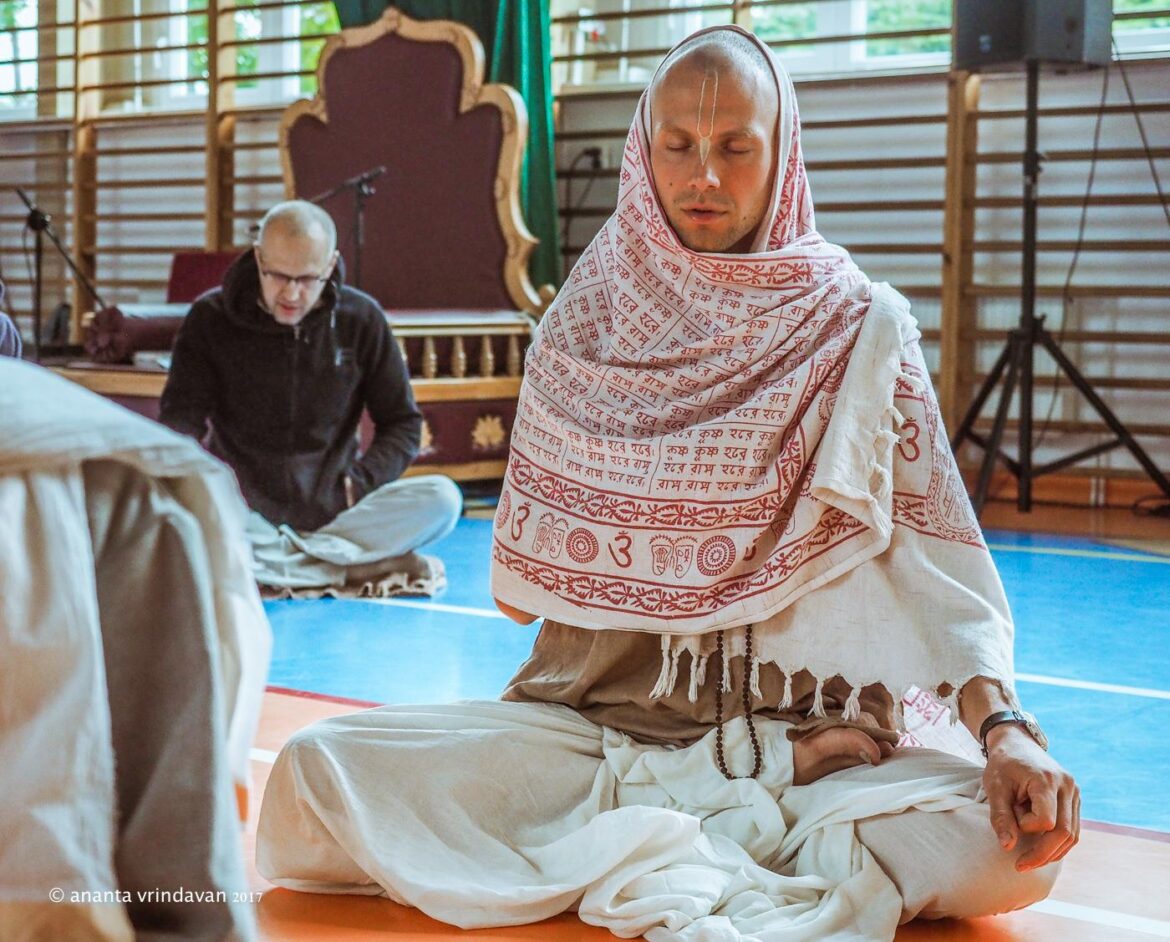1. INTRODUCTION TO THE MYSTERIES OF THE HARE KRISHNA MANTRA
The Hare Krishna Mantra, also known as the Maha Mantra, is the most famous and important holy chant of Krishna consciousness. As part of a tradition that spans thousands of years, the mantra aims to bring people closer to divine consciousness and spiritual enlightenment.
A brief historical review
The Hare Krishna mantra appears in ancient Indian scriptures, especially the Vedas and Puranas. But it also existed before these were written down. In fact, it has always existed and is a living mantra, not only here in the material world but also in the spiritual world. The use and significance of the chant has persisted over the millennia and has become particularly prevalent as part of the Bhakti movement. In the 16th century, Caitanya Mahaprabhu, a prominent figure in Gaudiya Vaisnavism and a manifestation of Krishna, gave the Maha Mantra to us all. So did you!
The meaning and words of the mantra
The Hare Krishna mantra is:
Hare Krisna, Hare Krisna, Krisna Krisna, Hare Hare,
Hare Rama, Hare Rama, Rama Rama, Hare Hare.
A Hare is the name of Radha, the beloved of Krishna, which is the manifestation of divine energy or divine love. A Krishna the Supreme Personality of Godhead, his name means attractive to all. A Rama is the source of divine joy.
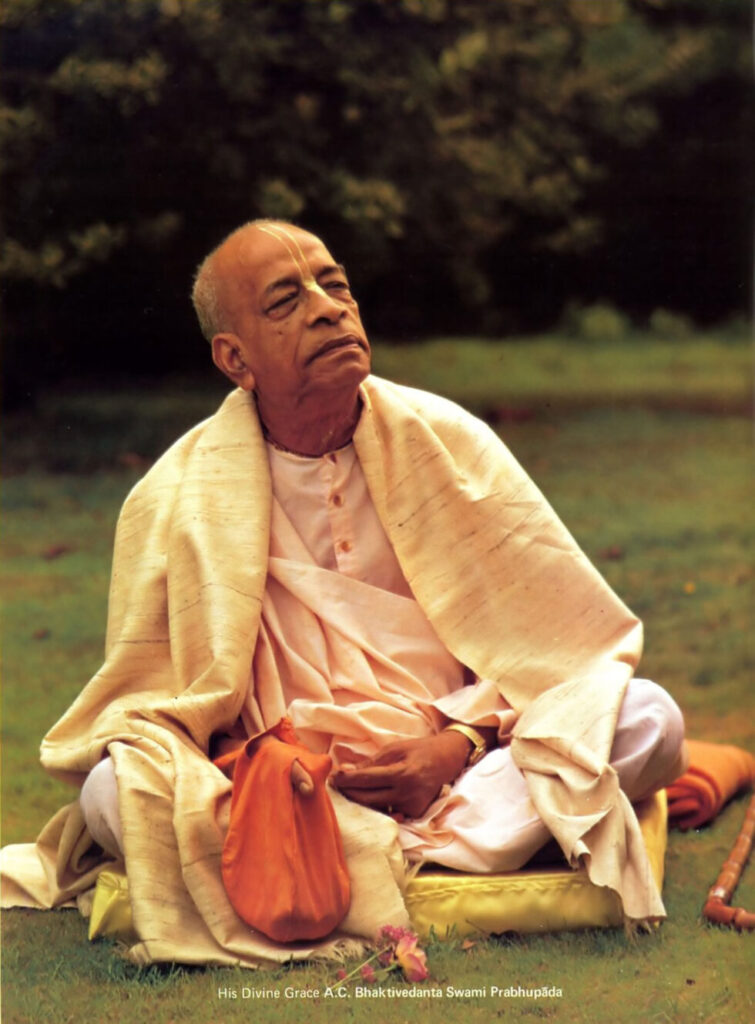
The Hare Krishna movement (Krishna-consciousness) and its founder Srila Prabhupada
In the 20th century, the teachings of the Hare Krishna mantra and Gaudiya Vaisnavism became known worldwide through Srila Prabhupada, who came to the United States in 1965. Srila Prabhupada founded the International Society of Krishna Conscious Believers (ISKCON), commonly known as the Hare Krishna movement. Through his work, the mantra and related teachings have reached millions, and ISKCON centres, temples and communities are active worldwide. Srila Prabhupada’s goal was to make people understand the importance of Krishna consciousness and practice the process of bhakti yoga through mantra chanting.
2. THE BASICS OF MANTRA CHANTING
Chanting, i.e. repeating sacred texts, is one of the most important elements of spiritual practice in many religions, including Krishna-consciousness.
What is chanting and why is it important
The purpose of chanting is to elevate the practitioner’s mind and soul to a higher state of consciousness and to establish a direct connection with the divine energy and Krishna Himself. The vibrations of the sounds and the intention associated with them help to clear the mind of negative thoughts and emotions, promoting inner peace, clarity and upliftment of the mind. Mantra chanting is one of the most important ways of expressing devotion and faith in the Divine, strengthening the believer’s faith and commitment.
The technique of japa (personal chanting)
A japa (pronounced japa) is a personal practice of repeating the mantra, performed in silence or in a low voice, usually with the help of a mala, or mantra chanting garland. The mala consists of 108 beads, and each repetition of the mantra is performed on one bead. The practitioner moves in a circle starting from one bead until he or she returns to the beginning. During the mantra, the practitioner concentrates fully on the words and meaning of the mantra, avoiding distracting thoughts. He does the mantra at regular intervals, daily, preferably at the same time and place.
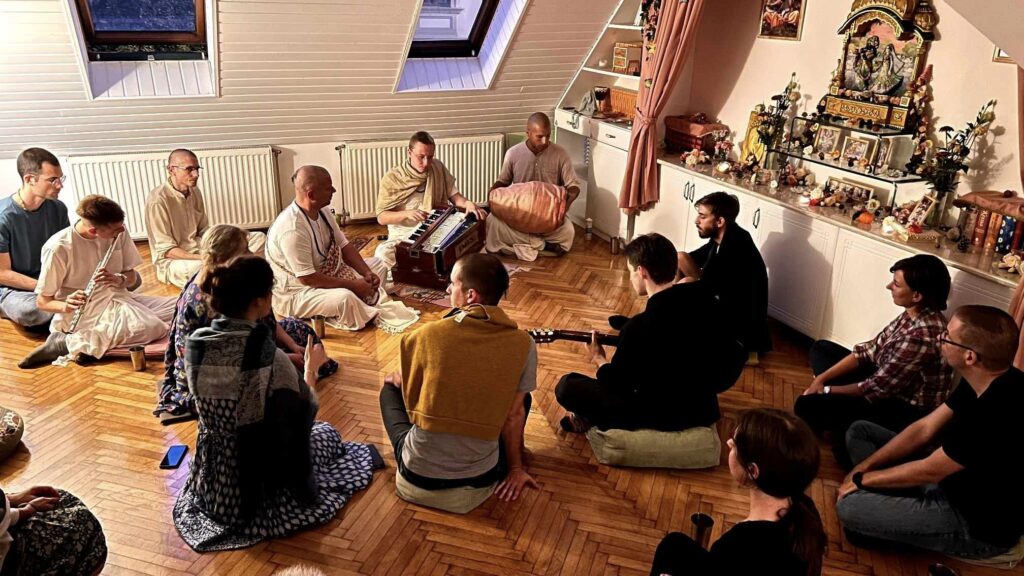
The importance of kirtan (communal chanting)
The kirtan is a communal form of mantra chanting, where believers chant the mantra in groups, often accompanied by an instrument. Kirtan brings believers together, strengthening community bonds and a shared spiritual experience. The dynamism and energy of communal chanting enhances the enthusiasm of participants and deepens the experience of mantra singing. Kirtan helps individuals raise their spiritual vibration and enter a higher state of consciousness that brings them closer to the divine presence.
3. THE SPIRITUAL AND PSYCHOLOGICAL EFFECTS OF THE MANTRA
Regular practice of the Hare Krishna mantra has significant effects not only spiritually but also psychologically. Chanting and repeating the mantra influences the practitioner’s life in many ways, promoting inner peace, emotional stability and the attainment of a higher state of consciousness.
The effect of mantra on consciousness and soul
Repeating the mantra regularly helps to clear the mind of negative thoughts and emotions. Chanting the Names of God drives away anxiety, fear and depression, bringing peace and calm instead.
A tool that allows the practitioner to have direct contact with Krishna. This contact can bring deep spiritual experiences and help the soul to find divine love and joy.
Chanting and repeating the mantra supports the self-realization process of us individuals, helping to understand our own spiritual nature.
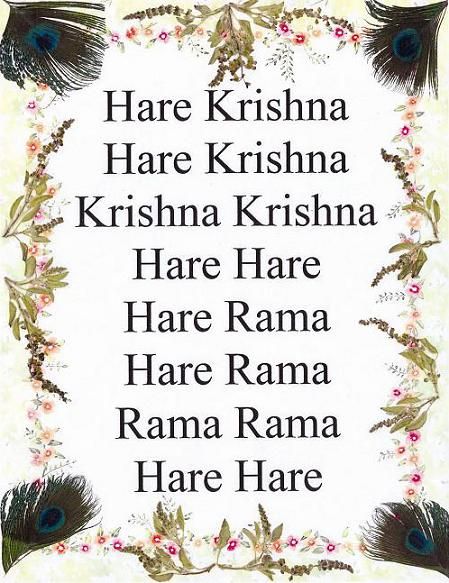
The benefits of mantra chanting for meditation and relaxation
By repeating the mantra, the practitioner focuses the mind on a point that improves concentration and mental focus. This can be particularly useful in everyday life where attention is often scattered.
Chanting reduces stress and anxiety through its calming effect. Regular practice helps balance the nervous system and reduce levels of cortisol, the stress hormone.
The constant rhythm and vibration of chanting induces a state of relaxation that promotes physical and mental well-being. After chanting, people often feel calmer, more balanced and energetic.
Scientific research and reports on the effects of mantras
Many studies have shown that chanting has positive effects on brain function, improving memory and cognitive function. Mantra chanting increases activity in the prefrontal cortex, which induces a state similar to meditation.
Many practitioners report that mantra chanting have changed their lives, improving their mental health, emotional stability, and spiritual deepening.
4. HOW TO START CHANTING THE MANTRA
Practicing Hare Krishna mantra is available to everyone and can be started with simple steps.

Basic steps to practicing the japa
1. Be mentally prepared: start the exercise with a calm and clear mind! Take a few deep breaths and focus on the mantra.
2. Use a mala: start with the main bead (Krishna bead), and go around repeating the mantra, bead-by-bead.
3. Focus on the mantra: repeat the mantra either loud, quietly or in your mind, but always focusing on the words and their meanings.
Hare Krisna, Hare Krisna, Krisna Krisna, Hare Hare,
Hare Rama, Hare Rama, Rama Rama, Hare Hare.
4. Repeat regularly: try to take time every day to chant. Start with 5-10 minutes a day and gradually increase the time.
5. Be persistent: practicing japa requires regularity and persistence. Don’t be discouraged if concentration seems difficult at first!
Recommended time and location for mantra chanting
The best time to mantra is in the early morning, when the environment is quiet and peaceful. This is a particularly good time for meditation and spiritual practice.
Evening hours are also suitable for mantras, especially at the time of the end of the day relaxation.
Find a place where there are few distractions! This could be a room at home, a park or a church. If you have the opportunity, visit sacred places, churches or community centres where you can have a communal experience of chanting!
Frequent mistakes and how to avoid them
- Lack of attention: one of the most common mistakes is to let your mind wander while chanting. Try to consciously return to the mantra when you notice that you are distracted!
- Repeating too fast or too slow: It is important to keep the rhythm of the mantra steady. Don’t rush, but don’t slow down the repetitions too much either.
- Mechanical repetition: avoid making the mantra mechanical! Always try to focus on the meaning and the feeling!
- Irregularity: regular practice is key. Try to chant at the same time every day to develop the habit!
- Disturbances: if your environment is noisy or disturbing, try to find a quieter place or time to practice.
5. TOOLS AND AIDS FOR CHANTING
The tools and aids used during chanting help practitioners to deepen their practice and support spiritual development.
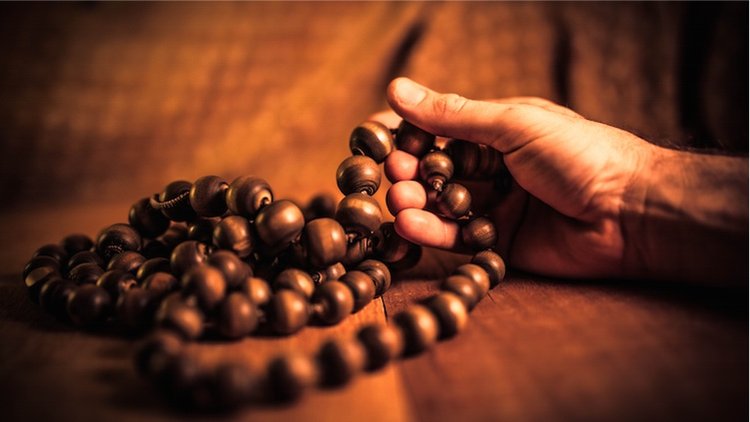
Use of a mala (garland of prayer beads)
This is a string of 108 beads that helps you count the repetitions of the mantra and maintain concentration. During the mantra, the practitioner starts at the main bead of the mala (Krishna bead) and with each repetition, continues with one bead until he or she reaches the beginning. Its use helps to keep the rhythm and steady tempo during the mantra.
The role of the altar
In the home, the practitioner can create a simpler form of the church altar by putting up pictures and perhaps statues of gods. The altar is a sacred space for practice, helping the practitioner to centre themselves spiritually and develop a sense of sacredness.
The altar is often decorated with flowers, incense and other sacred objects. The careful decoration of the altar helps to deepen the contemplation and to develop a personal relationship with the deities.
The role of the community and the guru in practice
Without the support and guidance of the community and the guru, practitioners can easily go astray or get lost in the practice. Participation in community allows practitioners to share experiences, inspire and help each other to develop.
The guidance and wisdom of the guru or spiritual teacher is essential for the right practice and for staying on the right path.
Why is accent and pronunciation important?
Emphasis and correct pronunciation help to retain the original vibration and energy of the mantra. Correct pronunciation helps the practitioner to fully immerse himself in the process of mantra chanting and to reach the deepest state of concentration.
Moreover, doesn’t everyone here in the material world like to have their names pronounced correctly? Krishna opines just the same.
6. Final thoughts
Inspiring stories from famous devotees
Many famous personalities, including musicians, writers and scientists, have shared inspiring stories about the practice of the Hare Krishna mantra and its positive effects. Their examples show that the practice of mantra can be accessible and beneficial to everyone in different walks of life. Some examples:
George Harrison: the Beatles’ legendary guitarist met the Hare Krishna movement and Srila Prabhupada in the late 1960s. He was greatly influenced by and regularly participated in mantras and community chanting. Subsequently, his music also incorporated Hindu and Sanskrit elements, for example, he based the song “My Sweet Lord” on the Hare Krishna mantra. Harrison has spoken openly about the practice of the mantra and its importance in his life.
Allen Ginsberg: the American poet and writer. In his poem “Hare Krishna”, written in 1969, he summarised his spiritual experience of the Hare Krishna mantra. In the poem he describes how the mantra led him to a state of inner peace and joy.
Boy George: The British singer, known for his unique style, has spoken openly in several interviews about his mantra, his religious beliefs and his experiences. These experiences have influenced his music and his art.
Russell Brand: The British comedian and actor has spoken openly about mantra practice and his feelings towards the Hare Krishna movement. He has spoken about his love of mantras and meditation and has made mantras and meditation an important part of his life in his recovery from addiction.
The importance of mantra in the modern world
In the modern world, where stress, anxiety and the fast pace of life are daily challenges, the practice of the Hare Krishna mantra can be particularly important. This practice provides an opportunity to find inner peace, reduce stress and discover a deeper meaning to life.
Encouragement to continue practicing
In any practice, whether it is mantra practice or anything else, continued perseverance and commitment are key. We encourage everyone to keep practicing, even if it sometimes seems difficult! Persistence and regularity will bring rich results in the long run.
Hare Krishna!



